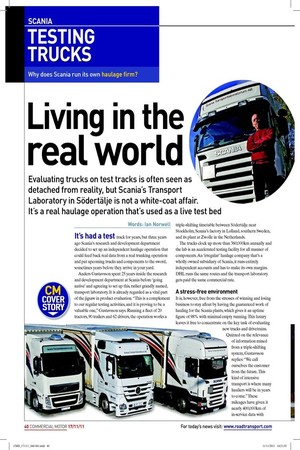Livi ingn the
Page 31

Page 32

If you've noticed an error in this article please click here to report it so we can fix it.
real world
Evaluating trucks on test tracks is often seen as detached from reality, but Scania’s Transport Laboratory in Södertälje is not a white-coat affair. It’s a real haulage operation that’s used as a live test bed
Words: Ian Norwell
It’s had a test track for years, but three years ago Scania’s research and development department decided to set up an independent haulage operation that could feed back real data from a real trunking operation and put upcoming trucks and components to the sword, sometimes years before they arrive in your yard.
Anders Gustavsson spent 25 years inside the research and development department at Scania before ‘going native’ and agreeing to set up this, rather grandly named, transport laboratory. It is already regarded as a vital part of the jigsaw in product evaluation. “This is a complement to our regular testing activities, and it is proving to be a valuable one,” Gustavsson says. Running a leet of 20 tractors, 90 trailers and 62 drivers, the operation works a triple-shifting timetable between Södertälje near Stockholm, Scania’s factory in Lolland, southern Sweden, and its plant at Zwolle in the Netherlands.
The trucks clock up more than 360,000km annually and the lab is an accelerated testing facility for all manner of components. An ‘irregular’ haulage company that’s a wholly owned subsidiary of Scania, it runs entirely independent accounts and has to make its own margins. DHL runs the same routes and the transport laboratory gets paid the same commercial rate.
A stress-free environment
It is, however, free from the stresses of winning and losing business to stay aloat by having the guaranteed work of hauling for the Scania plants, which gives it an uptime igure of 98% with minimal empty running. This luxury leaves it free to concentrate on the key task of evaluating new trucks and drivetrains.
Quizzed on the relevance of information mined from a triple-shifting system, Gustavsson replies: “We call ourselves the customer from the future. This kind of intensive transport is where many hauliers will be in years to come.” These mileages have given it nearly 400,000km of in-service data with R-series 400hp and 420hp and, more signiicantly, eight Euro-6 units at 480hp. Measuring lifecycle costs and uptime is the core of Gustavsson’s work and he’s canny enough to have a few competitors’ chassis in the leet as well. Next to the 17 home-grown tractors, CM walked past a Mercedes-Benz Actros 1841 at Euro-5, owned since new and with more than 500,000km behind it, a Volvo FH-420 and a 410hp MAN.
Regular servicing for all trucks is carried out at the local dealer for that marque and performance levels are measured in the minutest detail. “It’s not just about the product,” says Gustavsson. “We need to ask ourselves if our services are good enough too.” He was disarmingly honest when asked about the competitors’ fuel performance against Scania’s. “We get a little better fuel economy from the Scanias, but I put most of the difference down to our drivers being less familiar with the other brands.”
Working hard, playing hard
With average gross weights on the 13 daily trailers running out of the yard at just 34 tonnes and drivers working a regular 40-hour week, the lab is putting on big miles without working either the drivers or the trucks and trailers unreasonably hard. Indeed, drivetrains that remain at or near working temperatures all week and cool down only on their day of rest stand to set some records on the high mileage front. It is common here for vehicles to keep their engines for very lengthy periods, but if, for example, a new lightweight axle needed evaluation, the leet is there, ready and waiting.
Drivers are interviewed weekly by the bofins from Scania’s R&D department, who are looking for a detailed report on each truck’s performance with any exceptions or variations. Like a regular haulier, they don’t just look at the truck. Trailer side-skirts and ‘boat tail’ rear delectors on the trailers’ back doors, although only 30cm deep and permitted by EU regs, have brought a fuel saving of just under 4%. “For our trucks, which are consuming an average of 26 litres of fuel per 100km (10.86mpg), it represents an annual saving of around 4,000 litres of diesel, and that’s on every truck,” says Gustavsson. That could pay for an additional truck and trailer each year. ■










































